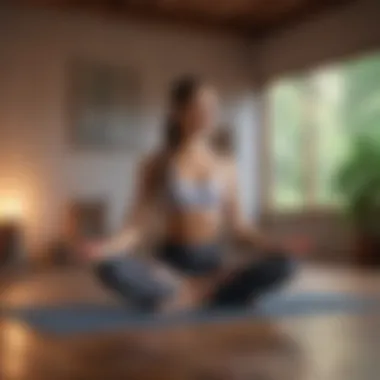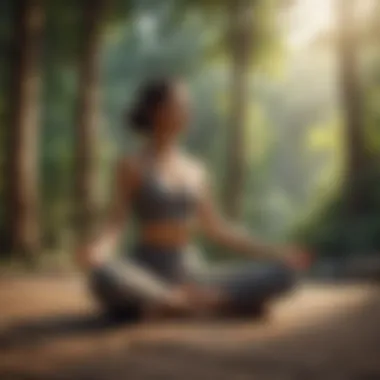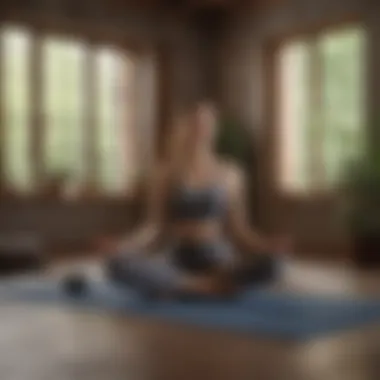Yoga Techniques for Deep Mental Relaxation


Intro
In today's fast-paced world, the quest for mental relaxation often feels like a daunting challenge. Stressful environments and constant distractions can overwhelm our minds. As a response, many people turn to yoga, a practice rooted in ancient traditions that simultaneously enhances physical and mental well-being. By integrating specific yoga techniques into daily routines, individuals can foster a calmer state of mind.
This article aims to illuminate the path of using yoga for mind relaxation. It delves into essential techniques, focusing particularly on guided meditation practices, and detailing their physiological and psychological impacts. The section highlights how guided meditation plays a vital role in promoting mental tranquility and reducing anxiety, ultimately leading to enhanced emotional health.
Guided Meditation Techniques
Guided meditation is a method that utilizes the guidance of a teacher or recorded instructions to lead practitioners through a meditative experience. This technique enhances relaxation, making it approachable for many.
Breathing Techniques
Breathing plays a fundamental role in yoga and meditation. It connects the mind and body, helping to bring awareness to the present moment. Various techniques are used to cultivate this connection. Here are some common breathing strategies:
- Diaphragmatic Breathing: Inhale deeply through the nose, allowing your abdomen to expand, then exhale slowly. This technique encourages optimal oxygen intake and promotes relaxation.
- Box Breathing: Inhale for four seconds, hold for four seconds, exhale for four seconds, and hold again for four seconds. This method helps to stabilize emotions and enhance focus.
- Alternate Nostril Breathing: Close one nostril with a finger, inhale through the open nostril, then switch and exhale through the other. This technique balances the body’s energy and calms the mind.
Visualization Practices
Visualization leverages the power of imagination to reduce stress. In guided meditation, practitioners are often led to envision peaceful settings or scenarios that induce a sense of calm. Here are some common visualization practices:
- Safe Space Visualization: Imagine a comforting and safe environment, such as a serene beach or quiet forest. Picture every detail, engaging all senses to deepen relaxation.
- Candle Flame Focus: Visualize a small flame, concentrating on its flicker and glow. Allow distractions to fade as you immerse yourself in this imagery.
- Color Breathing: As you breathe in, imagine inhaling a soothing color like blue or green, filling your body with peace. When exhaling, visualize releasing darker colors, which represent stress or tension.
"Meditation applies the power of intention, fostering a sense of calm and clarity in the chaotic environment around us."
Benefits of Guided Meditation
The benefits of incorporating guided meditation into yoga practice are profound. Beyond mere relaxation, these techniques significantly enhance overall mental health.
Enhancing Mindfulness
Guided meditation serves as a direct path to increased mindfulness. Mindfulness allows individuals to become more present and engaged with their thoughts and surroundings.
- It encourages self-awareness, helping practitioners to identify and address stress triggers.
- Regular practice can lead to more reflective thought patterns, promoting emotional stability.
Alleviating Anxiety
The soothing nature of guided meditation is particularly effective for anxiety reduction. By focusing the mind and calming the body, yoga practitioners can experience a notable decrease in anxious thoughts.
- Through controlled breathing and visualization, individuals can mitigate feelings of panic.
- Consistent practice can build resilience against stressors, leading to improved coping mechanisms in challenging situations.
In essence, the blending of yoga practices, especially guided meditation techniques, offers a structured approach to achieving a more relaxed mind and body. By prioritizing this integration, individuals can navigate life with greater ease and balance.
Understanding Yoga's Role in Mental Relaxation
Yoga serves as a multidimensional practice that profoundly contributes to mental relaxation. It encompasses various techniques that intertwine physical, mental, and spiritual components. The beauty of yoga lies in its ability to cater to individuals' unique needs while offering common pathways towards serenity and calmness. Many people today face the pressures of fast-paced lives, leading to stress and anxiety. Yoga provides not only a remedy but also a means of prevention for these mental health challenges.
Practicing yoga can facilitate mental relaxation by promoting mindfulness and enabling practitioners to tune in to their thoughts and emotions. This conscious engagement allows individuals to recognize stress triggers and work toward managing them effectively. Through engaging in yoga poses and breathwork, one can stimulate the parasympathetic nervous system, prompting the body's natural relaxation response.
Key benefits of incorporating yoga into relaxation practices include:
- Stress reduction: Regular yoga practice lowers stress hormone levels, which diminishes anxiety and enhances emotional well-being.
- Improved focus: Yoga encourages present-moment awareness, leading to a clearer mind and enhanced concentration.
- Greater emotional resilience: Practitioners often report better management of emotions, allowing them to respond to challenges in a more balanced manner.
By understanding the comprehensive role yoga plays in mental relaxation, individuals can better appreciate its significance. This section sets the stage for delving into the historical roots and contextualizing yoga within broader relaxation practices.
The Physiological Underpinnings of Yoga
Understanding the physiological underpinnings of yoga is crucial for grasping how this practice promotes mental relaxation. The interplay between body and mind plays a significant role in our overall well-being. The body responds to stress in specific ways, triggering various physiological changes. By comprehending these responses, individuals can harness yoga to cultivate calmness and reduce anxiety. The connection between breath and stress is especially significant. Breathing techniques form the foundation of many yoga practices, offering tools to manage the body's stress response effectively.
Understanding Stress Response


The stress response is a biological reaction that prepares the body to face challenges. When encountering stress, the body undergoes several changes, including increased heart rate and heightened alertness. This is often referred to as the fight-or-flight response. Although this response can be beneficial in certain situations, chronic stress can lead to detrimental health effects. Negative impacts include anxiety, insomnia, and even cardiovascular issues. Yoga addresses these concerns by promoting relaxation and regulating the stress response through mindful movement and breathing.
Breathing Techniques in Yoga
Breathing techniques are essential components of yoga, significantly impacting mental relaxation. Two prominent methods are diaphragmatic breathing and Ujjayi breath. Each technique offers distinct characteristics that aid in reducing stress and enhancing mindfulness.
Diaphragmatic Breathing
Diaphragmatic breathing involves using the diaphragm effectively during inhalation and exhalation. This method encourages full oxygen exchange, which is vital for physical and mental relaxation. The primary characteristic of diaphragmatic breathing is its ability to slow the heart rate and lower blood pressure. This makes it a popular choice for those seeking to calm their minds.
- Key benefits:
- Enhances oxygen flow to the brain
- Promotes a state of calm
- Supports emotional stability
A unique feature of this practice is its accessibility. Anyone can incorporate it into their daily routine, whether sitting, standing, or lying down. However, a disadvantage may arise for beginners who find it challenging to engage the diaphragm effectively. With practice, most can overcome this hurdle.
Ujjayi Breath
Ujjayi breath is characterized by a slight constriction of the throat, creating a sound similar to ocean waves. This breathing technique helps control the pace of breathing while fostering mindfulness. It serves as both a focus point and a calming mechanism.
- Key benefits:
- Increases oxygen intake
- Encourages presence and awareness
- Enhances concentration during yoga practice
The unique aspect of Ujjayi breath is its auditory feedback, which can deepen a practitioner's connection to their breath. It aids in regulating body temperature during practice, providing a sense of groundedness. However, beginners might initially struggle with the throat constriction required for effective execution.
"Breathing techniques in yoga facilitate a profound connection between the mind and body, enhancing relaxation and promoting emotional well-being."
In summary, the physiological underpinnings of yoga play a key role in promoting mental relaxation. Understanding stress response and integrating effective breathing techniques yields numerous health benefits that extend beyond yoga practice. As individuals begin to understand these principles, the practice of yoga may lead to a more balanced and tranquil state of mind.
Meditation: The Mental Component of Yoga
Meditation plays a crucial role in the practice of yoga, especially when it comes to achieving mental relaxation. While many people associate yoga with physical postures, meditation is the anchor that holds the entire practice together. Engaging effectively with the mind during meditation helps individuals reduce anxiety, enhance self-awareness, and improve overall mental health. This section will explore mindfulness as a pivotal practice within meditation and provide insights into guided meditation techniques that serve as valuable tools for mental clarity and emotional stability.
Mindfulness in Meditation
Mindfulness in meditation involves focusing on the present moment without judgment. The essence of this practice lies in observing thoughts, feelings, and bodily sensations as they arise. This non-reactive stance allows individuals to experience their mental state fully, leading to greater awareness and understanding of their inner emotional landscape.
Practicing mindfulness can yield numerous benefits, including:
- Reduced Stress: By concentrating on the present, individuals learn to let go of worries about the past or future.
- Enhanced Concentration: Regular practice improves the ability to focus, which is vital for mental clarity.
- Emotional Regulation: Mindfulness cultivates a calm and centered state, which enables better responses to stressful situations.
True mindfulness requires consistent practice. It can start with simple breathing exercises, where one focuses on each inhale and exhale, gradually increasing the duration of the sessions. This approach fosters not only relaxation but also cultivates a deeper connection with oneself.
"Mindfulness is the aware, balanced acceptance of the present experience. It isn’t more complicated than that."
Guided Meditation Practices
Guided meditation practices offer a structured approach to meditation, making it accessible for beginners and those who may find unstructured meditation challenging. During a guided session, an instructor or a recorded voice leads participants through various techniques, often concentrating on specific goals such as stress relief, emotional healing, or deep relaxation.
Various forms of guided meditation include:
- Body Scan Meditation: Participants are invited to focus on different parts of the body sequentially, promoting relaxation and awareness of physical sensations.
- Visualizations: Practitioners picture a peaceful place or scenario, allowing the mind to escape and relax fully. This method can transport the mind away from stressors and improve mood.
- Affirmation Meditations: These involve repeating positive statements to promote self-esteem and emotional stability. Affirmations strengthen the belief in one's abilities and worth.
For those interested in incorporating guided meditation into their routine, many apps and online resources are available. Some well-known platforms provide free access to guided sessions tailored to various needs and experience levels. Engaging regularly in guided meditation can increase resilience to stress and enhance overall mental wellness.
Key Yoga Poses for Mental Calmness
The practice of yoga encompasses various postures that contribute significantly to mental relaxation. Understanding key yoga poses helps individuals access a state of tranquility. These poses serve dual purposes; they enhance physical well-being and create a harmonious environment for mental serenity. Such practices also promote trigger points within the body that can dissipate stress, clarity emerges when the mind is at ease.


Child's Pose: A Restorative Position
Child's Pose, or Balasana, epitomizes restorative yoga. This pose mimics the fetal position, offering comfort and a sense of security. In this pose, the body folds over itself, creating gentle pressure on the abdomen, which can aid in emotional release. Practicing Child's Pose provides several benefits, including:
- Reducing anxiety and stress
- Lowering heart rate
- Releasing tension in the neck and shoulders
To perform Child's Pose, kneel on the mat, touch your big toes together, and sit back on your heels. Then, lower your torso between your thighs and stretch your arms forward or rest them alongside your body. Breathe deeply and allow your mind to quiet.
Legs-Up-The-Wall Pose
Legs-Up-The-Wall Pose, known as Viparita Karani, is an accessible inversion that promotes blood circulation while calming the mind. This pose encourages relaxation through its grounding effect on the body. By elevating the legs, practitioners can:
- Ease tension in the lower back
- Promote lymphatic drainage
- Encourage a sense of calmness throughout the body
To practice this pose, find a clear wall space. Sit next to the wall and gently swing your legs up onto the wall while lying back on your mat. The position provides gentle support to the lower back. Close your eyes and deeply engage with your breath, fostering a serene mental state.
Seated Forward Bend
The Seated Forward Bend, or Paschimottanasana, offers both physical stretches and mental benefits. This pose involves bending forward from a seated position, which naturally lengthens the spine and calms the nervous system. Benefits of Seated Forward Bend include:
- Alleviating tension in the back and hamstrings
- Calming the mind
- Enhancing concentration and focus
To perform this pose, sit on the mat with your legs extended in front of you. Inhale, reaching your arms overhead. Exhale as you hinge at the hips to fold forward, easily grasping your feet or shins. Each inhale can create length in the spine, and with each exhale, create a deeper surrender into the pose.
Practicing these key poses regularly can significantly contribute to a more balanced, calm mind and a greater sense of overall well-being.
These postures serve as effective tools in enhancing mindfulness. They provide pathways to ease the mind's chatter and promote psychological health. Integrating these poses into daily yoga practice enhances mental calmness and wellness.
Incorporating Yoga into Daily Life
Incorporating yoga into daily life is essential to harness its full mental relaxation benefits. Regular practice can facilitate better emotional regulation, stress reduction, and cultivate mindfulness. The structuring of a practice that aligns with personal routines ensures that yoga becomes a sustainable part of one’s lifestyle. It not only enhances mental clarity but also fosters a holistic approach to well-being, bridging mind, body, and spirit.
Establishing a Routine
Establishing a routine is a fundamental step in making yoga a consistent part of one's daily life. Having a structured practice helps in setting intentions and reinforces commitment.
Morning Practices
Morning practices set a positive tone for the day ahead. Engaging in yoga sessions early in the morning can refresh both body and mind. The key characteristic of morning practices is their energizing effect. This can lead to a clearer mindset and increased focus throughout the day. For many, the quietness of the morning is a unique feature that facilitates deeper connection and reflection.
Advantages of morning yoga include a boost in motivation and productivity, as well as improving mood. However, some may find it challenging to wake up early enough to incorporate this practice, which might discourage consistency.
Evening Wind-Down Sessions
Evening wind-down sessions can play an important role in helping individuals transition from the hustle of daily life to a more relaxed state. These sessions focus on releasing built-up tension and stress accumulated throughout the day. The key characteristic of this practice is its calming pace. It allows for introspection, facilitating deeper relaxation.
The unique feature of evening yoga is that it prepares the body for a restful night’s sleep. While many appreciate this calming effect, those with busy evenings might struggle to fit this routine into their lives, posing a potential barrier to regular practice.
Adaptability of Yoga Practices
Yoga's adaptability is one of its prominent strengths. Each individual can tailor their practice based on personal needs, preferences, and time constraints. This flexibility means that yoga can fit seamlessly into nearly any schedule or lifestyle. Whether a practitioner prefers a brief session of five minutes or a comprehensive one lasting hours, the possibilities are vast.
This adaptability also ensures that yoga remains inclusive, accommodating different fitness levels and physical abilities. Whether at home or in a class setting, practitioners can modify poses or sequences to suit their comfort level. Additionally, practitioners can choose from various styles such as hatha, vinyasa, or restorative yoga, which further enhances their ability to engage meaningfully with the practice.
In summary, incorporating yoga into daily life not only aids in mental relaxation but also promotes overall well-being. By establishing a routine, adapting practices to suit individual needs, and recognizing the benefits of morning and evening sessions, anyone can experience the profound impact of yoga on their mental health.
Assessing the Impact of Yoga on Mental Health
Understanding how yoga influences mental health is essential. This section highlights the various impacts of yoga on mental well-being, discussing its effectiveness in reducing anxiety, improving mood, and enhancing overall life satisfaction. By examining both short-term and long-term benefits, we get a comprehensive look at how regular practice can lead to changes in mental health status.


Short-Term Benefits
When individuals begin practicing yoga, they may experience immediate effects. The short-term benefits often include a reduced sense of anxiety and increased feelings of calmness. These changes can be attributed to the physiological responses during yoga sessions.
- Increased relaxation: Engaging in yoga poses encourages relaxation of both the body and mind.
- Enhanced focus: Many practitioners find their ability to concentrate improves after a session. This moment of clarity is significant in reducing daily stressors.
- Mood elevation: The release of endorphins during yoga practice contributes to an uplifted mood.
- Immediate stress relief: A short session can diminish feelings of stress, providing a quick escape from daily pressures.
Practitioners often note a sense of grounding and connection to their physical selves, which enhances overall emotional resilience.
"Yoga is the journey of the self, through the self, to the self."
– The Bhagavad Gita
Long-Term Mental Wellness
The long-term effects of consistent yoga practice can be profound and far-reaching. Regularly engaging in yoga not only maintains mental health but can also contribute to overall emotional stability over time.
- Reduced symptoms of anxiety and depression: Many studies show significant improvements in individuals diagnosed with anxiety disorders or depression after sustained yoga practice.
- Improved coping mechanisms: Yoga encourages mindfulness and emotional regulation, leading to healthier responses to stressors.
- Enhanced self-awareness: Regular practice fosters a deeper understanding of one's thoughts and emotions, allowing for constructive growth.
- Sustained well-being: Long-term yogis often report greater satisfaction with life and improved relationships due to enhanced emotional intelligence.
Maintaining a consistent practice can lead to lasting changes in one’s mental landscape, where stress becomes easier to manage and emotional challenges can be addressed more constructively.
Challenges of Practicing Yoga for Relaxation
Practicing yoga for mental relaxation offers many benefits, but it is essential to recognize the challenges that may arise. Understanding these challenges can help practitioners develop a more robust and resilient yoga practice. Addressing misconceptions, overcoming barriers, and fostering a supportive environment are crucial in the journey toward inner peace.
Common Misconceptions
Many people hold misconceptions about yoga that may hinder their practice or prevent them from starting. Some believe that yoga is exclusively for the physically fit or flexible. This notion can discourage individuals who do not see themselves as fitting these categories. In reality, yoga is accessible to people of all body types and fitness levels. Modifications and props are often available to assist practitioners in achieving poses that work for their unique bodies.
Another misconception is that yoga requires a spiritual or religious commitment. While some yoga traditions emphasize spirituality, many modern practices focus solely on physical and mental well-being. Practicing yoga can be about personal growth and stress relief without the need for any specific beliefs.
Furthermore, some may assume that yoga is a quick fix for mental relaxation. While certain sessions can provide immediate relief, the benefits of yoga generally accumulate over time. Building a consistent practice is key to experiencing substantial mental health improvements, and this can be a deterrent for those seeking instant results.
Overcoming Barriers to Practice
Identifying obstacles to practicing yoga is crucial for anyone pursuing relaxation and mental wellness. Time constraints often emerge as a significant barrier. In a hectic lifestyle, it may seem challenging to carve out time for yoga. However, even short sessions can yield benefits. A ten-minute practice focusing on breathing or gentle stretches can create a sense of calm without requiring a substantial time commitment.
Physical discomfort or health issues can also present challenges. Beginners may feel overwhelmed by the perceived demands of yoga poses. Engaging with a qualified instructor can help. They can offer guidance on modifications and ensure a safe practice.
Environmental factors can play a significant role as well. A noisy or cluttered space may be distracting and inhibit relaxation. It is essential to create a peaceful environment dedicated to your practice. Consider setting up a specific area in your home that is clean and quiet, enhancing the yoga experience.
"The journey of yoga is an ongoing process where patience plays a vital role in achieving relaxation."
Fostering a community or finding support can be helpful too. Joining a local class or online group can provide encouragement and accountability. Engaging in discussions can also demystify common fears and challenges.
In summary, while challenges may exist in practicing yoga for relaxation, understanding misconceptions and proactively addressing barriers can enhance the experience. Embracing yoga as an adaptable and inclusive practice allows a broader audience to benefit from its calming effects.
Closure: The Path Forward
In this final section, the emphasis lies on the integrative approach to incorporating yoga into daily life. As explored throughout the article, yoga serves not only as a physical practice but also as a mental tool that aids in achieving relaxation of the mind. The key is making yoga a permanent fixture in one’s lifestyle. Benefits extend beyond immediate relaxation; regular practice encourages better stress management, improved emotional health, and enhanced cognitive function over time.
Understanding that each individual’s experience with yoga varies is crucial. It is important to tailor practices to personal needs, preferences, and life circumstances. This customization ensures a more engaging experience, leading to sustainable benefits.
"The journey of yoga is not just about mastering poses; it's about finding your rhythm in life."
Integrating Learnings into Lifestyle
Implementing yoga into everyday life requires mindful planning. First steps may involve setting aside specific times for practice, be it early morning or before bed. Morning practices can set a positive tone for the day while evening sessions facilitate winding down. Here are a few strategies to integrate learnings:
- Create a Dedicated Space: Designate a spot in your home that feels serene and inviting for yoga. This can enhance motivation.
- Start Small: Begin with short sessions to avoid feeling overwhelmed. Gradually increase duration as comfort and familiarity builds.
- Utilize Technology: Consider apps or online classes that offer guided classes, making it more accessible.
- Daily Breathing Exercises: Incorporate breathing techniques throughout the day to alleviate stress without needing to practice full routines.
Regularly revisiting and modifying practices can prevent stagnation and keep the engagement alive. Practitioners should also reflect on their progress and adapt their routines in response to shifting personal circumstances and goals.
Building a Sustainable Practice
A sustainable yoga routine hinges on consistency and enjoyment. Finding joy in the practice is essential for long-term commitment. Here are suggestions to help maintain a sustainable practice:
- Join a Community: Engage with local yoga groups or online forums. Communities provide support and motivation while fostering a shared commitment to mindfulness.
- Explore Different Styles: Experiment with various yoga styles like Hatha, Vinyasa, or Restorative. This exploration can reveal what resonates most with you.
- Set Realistic Goals: Establish achievable goals that consider your lifestyle and availability. This could be as simple as practicing three times a week.
- Reflect on Benefits: Regularly assess the impact of yoga on your mental health and well-being. Acknowledging these changes can reinforce commitment.
To conclude, the integration of yoga into daily life is not simply an addition to one's schedule; it’s about embracing a mindset focused on mental relaxation and overall wellness. Through conscious implementation and a flexible approach, the practice of yoga can yield rich dividends in creating a balanced life.















